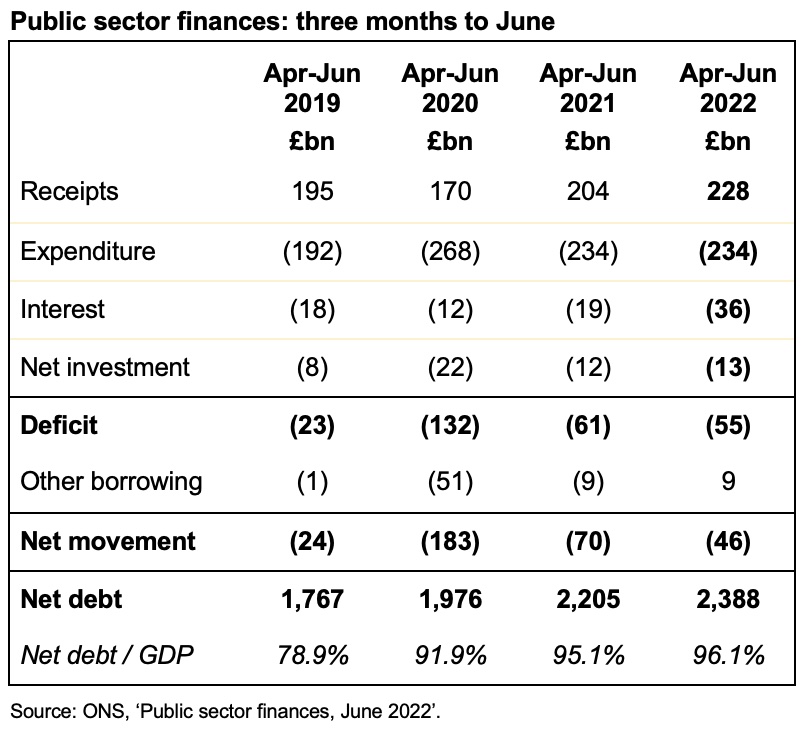Economic pressures mount as the public sector deficit reaches £55bn in the first three months of the fiscal year.
The monthly public sector finances for June 2022, released on Thursday 21 July 2022, reported a provisional deficit for the month of £23bn, bringing the total for the first quarter of the 2022/23 financial year to £55bn.
The first quarter deficit was £6bn below this time last year, but £32bn higher than the £23bn reported for the first three months of 2019/20, before the pandemic.
Public sector net debt increased to £2,388bn or 96.1% of GDP at the end of June, up £46bn from £2,342bn at the end of March 2022. This is £595bn higher than 31 March 2020, reflecting the huge sums borrowed over the course of the pandemic.
Tax and other receipts in the first quarter to 30 June amounted to £228bn, £24bn or 11% higher than a year previously. This included higher income tax receipts from wage increases and bonuses as well as the new higher rate of national insurance, plus higher VAT receipts driven by higher retail prices.
Expenditure excluding interest and investment for the quarter of £234bn was £1bn higher than the same period last year, as reduced spending on the pandemic (including furlough programmes) was offset by planned increases in spending announced in last year’s Spending Review and by additional support to households to help with their energy bills.
Interest charges of £36bn were recorded for the three months, £17bn or 39% higher than the £19bn in the equivalent period in 2021, driven by rising inflation increasing the cost of RPI-linked debt in addition to higher interest rates. This reflects how the government’s hedge against low inflation – which saw interest charges fall even as debt quadrupled over the last 15 years – went into reverse, with the benefit (to the government) of debt inflating away more quickly offset by a higher cost of borrowing.
Net public sector investment in the quarter was reported to be £13bn, which is £1bn or 7% higher than a year previously.
The increase in net debt of £46bn since the start of the financial year comprises the deficit for the quarter of £55bn less £9bn in net repayments. This reflects the recovery of loans to banks through the Bank of England’s Term Funding Scheme and of loans to businesses via the British Business Bank (including bounce-back and other coronavirus loans), offset by outflows to fund student loans and other government cash requirements.
Alison Ring OBE FCA, Public Sector and Taxation Director for ICAEW, said: “The latest inflation-fuelled numbers will provide little comfort for the new Prime Minister, as at £55bn for the quarter to June, the deficit is more than double what it was before the pandemic.
“With inflation at a 40-year high and record energy prices this winter, the question facing the next Prime Minister and Chancellor will not be about whether or not to write another cheque to struggling families, but how big it will be.
“Meanwhile, rising supplier cost inflation and public sector pay demands that are unlikely to be satisfied by a proposed 5% increase will put severe pressure on both operating and capital budgets. Combined with long-term demographic trends that continue to drive public spending higher, the likelihood is that any tax cuts promised during the Conservative party leadership campaign will end up being reversed in the years ahead.”

Caution is needed with respect to the numbers published by the ONS, which are expected to be repeatedly revised as estimates are refined and gaps in the underlying data are filled.
The ONS made several revisions to prior period fiscal numbers to reflect revisions to estimates. These had the effect of reducing the reported fiscal deficit for the two months ended 31 May 2022 by £3bn from £36bn to £33bn and the reported fiscal deficit for the twelve months to March 2022 by £2bn from £144bn to £142bn.